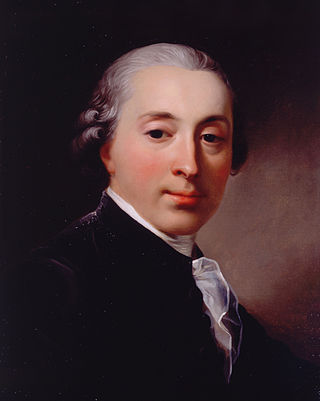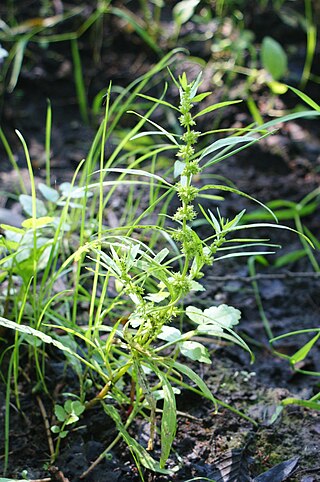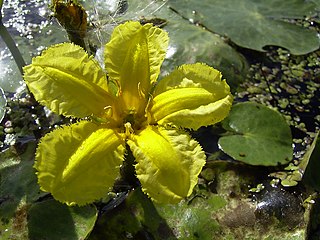
Plant cells are the cells present in green plants, photosynthetic eukaryotes of the kingdom Plantae. Their distinctive features include primary cell walls containing cellulose, hemicelluloses and pectin, the presence of plastids with the capability to perform photosynthesis and store starch, a large vacuole that regulates turgor pressure, the absence of flagella or centrioles, except in the gametes, and a unique method of cell division involving the formation of a cell plate or phragmoplast that separates the new daughter cells.

Photosynthesis is a biological process used by many cellular organisms to convert light energy into chemical energy, which is stored in organic compounds that can later be metabolized through cellular respiration to fuel the organism's activities. The term usually refers to oxygenic photosynthesis, where oxygen is produced as a byproduct and some of the chemical energy produced is stored in carbohydrate molecules such as sugars, starch, glycogen and cellulose, which are synthesized from endergonic reaction of carbon dioxide with water. Most plants, algae and cyanobacteria perform photosynthesis; such organisms are called photoautotrophs. Photosynthesis is largely responsible for producing and maintaining the oxygen content of the Earth's atmosphere, and supplies most of the biological energy necessary for complex life on Earth.

Wetlands, or simply a wetland, is a distinct ecosystem that is flooded or saturated by water, either permanently or seasonally. Flooding results in oxygen-free (anoxic) processes prevailing, especially in the soils. The primary factor that distinguishes wetlands from terrestrial land forms or water bodies is the characteristic vegetation of aquatic plants, adapted to the unique anoxic hydric soils. Wetlands are considered among the most biologically diverse of all ecosystems, serving as home to a wide range of plant and animal species. Methods for assessing wetland functions, wetland ecological health, and general wetland condition have been developed for many regions of the world. These methods have contributed to wetland conservation partly by raising public awareness of the functions some wetlands provide. Constructed wetlands are designed and built to treat municipal and industrial wastewater as well as to divert stormwater runoff. Constructed wetlands may also play a role in water-sensitive urban design.

A fen is a type of peat-accumulating wetland fed by mineral-rich ground or surface water. It is one of the main types of wetlands along with marshes, swamps, and bogs. Bogs and fens, both peat-forming ecosystems, are also known as mires. The unique water chemistry of fens is a result of the ground or surface water input. Typically, this input results in higher mineral concentrations and a more basic pH than found in bogs. As peat accumulates in a fen, groundwater input can be reduced or cut off, making the fen ombrotrophic rather than minerotrophic. In this way, fens can become more acidic and transition to bogs over time.

Aquatic plants are plants that have adapted to living in aquatic environments. They are also referred to as hydrophytes or macrophytes to distinguish them from algae and other microphytes. A macrophyte is a plant that grows in or near water and is either emergent, submergent, or floating. In lakes and rivers macrophytes provide cover for fish, substrate for aquatic invertebrates, produce oxygen, and act as food for some fish and wildlife.

Jean Senebier was a Genevan Calvinist pastor and naturalist. He was chief librarian of the Republic of Geneva. A pioneer in the field of photosynthesis research, he provided extensive evidence that plants consume carbon dioxide and produced oxygen. He also showed a link between the amount of carbon dioxide available and the amount of oxygen produced and determined that photosynthesis took place at the parenchyma, the green fleshy part of the leaf.

C4 carbon fixation or the Hatch–Slack pathway is one of three known photosynthetic processes of carbon fixation in plants. It owes the names to the 1960s discovery by Marshall Davidson Hatch and Charles Roger Slack that some plants, when supplied with 14CO2, incorporate the 14C label into four-carbon molecules first.

A hydrosere is a plant succession which occurs in an area of fresh water such as in oxbow lakes and kettle lakes. In time, an area of open freshwater will naturally dry out, ultimately becoming woodland. During this change, a range of different landtypes such as swamp and marsh will succeed each other.

Distichlis palmeri is an obligate emergent perennial rhizomatous dioecious halophytic C4 grass in the Poacea (Gramineae) family. D. palmeri is a saltwater marsh grass endemic to the tidal marshes of the northern part of The Gulf of California and Islands section of the Sonoran Desert. D.palmeri is not drought tolerant. It does withstand surface drying between supra tidal events because roots extend downward to more than 1 meter where coastal substrata is still moist.

Rumex palustris, or marsh dock, is a plant species of the genus Rumex, found in Europe. The species is a dicot belonging to the family Polygonaceae. The species epithet palustris is Latin for "of the marsh" which indicates its common habitat.

Nymphoides peltata is perennial, rooted aquatic plant with floating leaves of the family Menyanthaceae.

Stuckenia pectinata, commonly called sago pondweed or fennel pondweed, and sometimes called ribbon weed, is a cosmopolitan water plant species that grows in fresh and brackish water on all continents except Antarctica.

Tecticornia pergranulata is a succulent halophytic plant species in the family Chenopodiaceae, native to Australia. This plant is commonly tested in labs involving its C3 photosynthesis and its unique resistance to salinity and adversity.

Ranunculus fluitans is a species of buttercup. It is a perennial water plant, which when in favourable conditions can grow up to 6 m (20 ft) height.

Elachista pomerana is a moth of the family Elachistidae found in Europe.

Deepwater rice are varieties of rice grown in flooded conditions with water more than 50 cm (20 in) deep for at least a month. More than 100 million people in Southeast Asia including Northeastern India rely on deepwater rice for their sustenance. Two adaptations permit the rice to thrive in deeper water, floating rice and traditional talls. Traditional talls are varieties that are grown at water depths between 50 and 100 cm and have developed to be taller and have longer leaves than standard rice. Floating rice grows in water deeper than 100 cm through advanced elongation ability. This means when a field where rice is growing floods, accelerated growth in the internodal of the stem allows the plant to keep some of its foliage on top of the water. The O. s. indica cultivar is the main type of deepwater rice, although varieties of O. s. japonica have been found in Burma and Assam Plains.

Leymus mollis is a species of grass known by the common names American dune grass, American dune wild-rye, sea lyme-grass, strand-wheat, and strand grass. Its Japanese name is hamaninniku. It is native to Asia, where it occurs in Japan, China, Korea, and Russia, and northern parts of North America, where it occurs across Canada and the northern United States, as well as Greenland. It can also be found in Iceland.

Ranunculus trichophyllus, the threadleaf crowfoot, or thread-leaved water-crowfoot, is a plant species in the genus Ranunculus, native to Europe, Asia and North America.

Warnstorfia exannulata is a leafy branching wetland moss in the genus Warnstorfia within the family Amblystegiaceae and class Bryopsida. This bryopsida moss is also known as ringless-hook moss or Warnstorfia moss. It is the most common species of the genus in wetland environments and can be difficult to distinguish from others within the genus. It grows in acidic soils like fens and bogs, or in freshwater pools and lakes.

Ethylene (CH
2=CH
2) is an unsaturated hydrocarbon gas (alkene) acting as a naturally occurring plant hormone. It is the simplest alkene gas and is the first gas known to act as hormone. It acts at trace levels throughout the life of the plant by stimulating or regulating the ripening of fruit, the opening of flowers, the abscission (or shedding) of leaves and, in aquatic and semi-aquatic species, promoting the 'escape' from submergence by means of rapid elongation of stems or leaves. This escape response is particularly important in rice farming. Commercial fruit-ripening rooms use "catalytic generators" to make ethylene gas from a liquid supply of ethanol. Typically, a gassing level of 500 to 2,000 ppm is used, for 24 to 48 hours. Care must be taken to control carbon dioxide levels in ripening rooms when gassing, as high temperature ripening (20 °C; 68 °F) has been seen to produce CO2 levels of 10% in 24 hours.




























